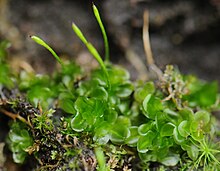| Oedipodium | |
|---|---|

| |
| Oedipodium griffithianum | |
| Scientific classification | |
| Kingdom: | Plantae |
| Division: | Bryophyta |
| Class: | Polytrichopsida Goffinet & W.R.Buck[3] |
| Order: | Oedipodiales Goffinet & W.R.Buck[3] |
| Family: | Oedipodiaceae Schimp.[2] |
| Genus: | Oedipodium Schwägr.[1] |
| Species: | O. griffithianum
|
| Binomial name | |
| Oedipodium griffithianum (Dickson) Schwägr.[1]
| |
| Synonyms[4] | |
| |
Oedipodium is the only genus of moss in the family Oedipodiaceae. It contains the single species Oedipodium griffithianum, the gouty-moss[5] or Griffith's oedipodium moss.[6] This species is distributed in cooler climates of Eurasia, as well as from Alaska, Washington state, British Columbia, Yukon, Greenland, Newfoundland, Tierra del Fuego and the Falkland Islands.[7]
The relationship of Oedipodium to other mosses has been much debated. Previously, the taxon has been included with the Funariales or the Splachnales. However, characteristics of the protonemata and asexual propagation, along with molecular evidence, point to a closer relationship with the Tetraphidaceae.[7]
order Oedipodiales
|
|
| The phylogenetic position of Oedipodium among the eight classes of mosses, based on inferences from DNA sequence data.[8][3] |
References
[edit]- ^ a b Schwägrichen, Christian Friedrich (1823). Species Muscorum frondosorum. Vol. Supplementum 2 (1, 1). p. 15.
- ^ Schimper, Wilhelm Philippe (1876). Synopsis Muscorum Europaea. Vol. XCVIII (2nd ed.). Stuttgart. p. 354.
{{cite book}}: CS1 maint: location missing publisher (link) - ^ a b c Goffinet, Bernard; William R. Buck (2004). "Systematics of the Bryophyta (Mosses): From molecules to a revised classification". Monographs in Systematic Botany. Molecular Systematics of Bryophytes. 98. Missouri Botanical Garden Press: 205–239. ISBN 1-930723-38-5.
- ^ Tropicos, Oedipodium griffithianum
- ^ Edwards, Sean R. (2012). English Names for British Bryophytes. British Bryological Society Special Volume. Vol. 5 (4 ed.). Wootton, Northampton: British Bryological Society. ISBN 978-0-9561310-2-7. ISSN 0268-8034.
{{cite book}}:|journal=ignored (help) - ^ USDA, NRCS (n.d.). "Oedipodium griffithianum halleriana". The PLANTS Database (plants.usda.gov). Greensboro, North Carolina: National Plant Data Team. Retrieved 4 February 2016.
- ^ a b Crum, Howard A. (2002). "Oedipodiaceae". Flora of North America. Vol. 27. pp. 116–117. ISBN 978-0-19-531823-4.
- ^ Goffinet, B.; W. R. Buck & A. J. Shaw (2008). "Morphology and Classification of the Bryophyta". In Bernard Goffinet & A. Jonathan Shaw (eds.). Bryophyte Biology (2nd ed.). Cambridge: Cambridge University Press. pp. 55–138. ISBN 9780521872256.
Well, that’s interesting to know that Psilotum nudum are known as whisk ferns. Psilotum nudum is the commoner species of the two. While the P. flaccidum is a rare species and is found in the tropical islands. Both the species are usually epiphytic in habit and grow upon tree ferns. These species may also be terrestrial and grow in humus or in the crevices of the rocks.
View the detailed Guide of Psilotum nudum: Detailed Study Of Psilotum Nudum (Whisk Fern), Classification, Anatomy, Reproduction